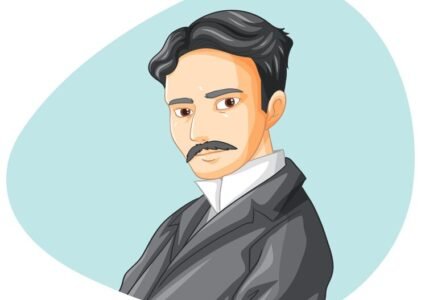WAS HE A GENIUS?

As a young child studying in the schools of the Austro-Hungarian military frontier, Tesla was deeply interested in the demonstrations of electricity given to him by his physics teacher. After some time, he barely evaded entering into the army via escaping, while surviving in the woods, and recovering from illness (cholera) with the help of Mark Twain’s books. Also, he was a bright student, being able to perform integration in his mind.
HIS INVENTIONS

Tesla, later on, met an attorney (Charles Fletcher) and a Western Union superintendent (Alfred S. Brown), who agreed with him to set up a company named “Tesla Electric Company”.
At the company, he developed an Induction Motor which relied on alternating current to receive power, which is one of, if not the most important device invented by humanity. It used a rotating magnetic field to turn the rotor (the part of an electrical machine which rotates), therefore saving external energy input required to move the rotor.
Also, he developed the Tesla coil, which uses Alternating current to transmit high voltage and high frequency current. Therefore, it is used as a device for transferring electrical energy from one circuit to another.
He was ahead of his time as well. He developed the Magnifying Transmitter, which was a larger version of the Tesla coil, being able to shoot electric sparks/beams (lightning bolts) that were approximately 130 feet long (Also, there were some fatal flaws with this method, but with time, humans improvised). This technology wasn’t invented until 2005, that is, when some MIT researchers formed a team to invent a method of wireless electric transmission which was practical at greater distances. (Heinrich Hertz did some work on wireless electricity transmission as well)
Tesla created the first design for radio remote control, sparking the interest of the Italian Marconi, who later invented the first radio, although lawsuits by Tesla followed, leading to him winning the radio patent. However, we must acknowledge the contribution of both scientists equally.
He also created the Tesla Turbine, which, when oversimplified, is, “Make water flow through a spinning disc to harness energy.” This is inefficient. So let’s put it in a casing so that the water goes to the centre, spinning along as it generates energy. The faster it moves, the time for which the fluid is in contact with the disc increases, which increases the viscous force (the force arising due to contact between a fluid and the surface on which the fluid is flowing). However, it is not used today because a very high revolution rate is required (for greater efficiency), which wastes more energy. Also, such speeds are nigh-impossible to achieve. Therefore, we have to reduce the revolution rate, wasting more energy. If we do manage to achieve such speeds in practice, we don’t know about a material which can withstand the force of the fluid.
So, we stick to modern turbines because we’ve already established them. Establishing a new kind of turbine will require huge investment.
HIS BRAIN

Tesla had a photographic memory, allowing him to become a polyglot (one who speaks many languages). Not only that, but he used to encounter a solution to a problem via extreme visualisation, as he saw visions which were linked to an idea he had recently learnt: such was his interest in innovation.
——————————————————————-
What we can learn from the great inventor’s story is that the mind is sharper in solitude, and that we should use our mind to make the world a better place.


